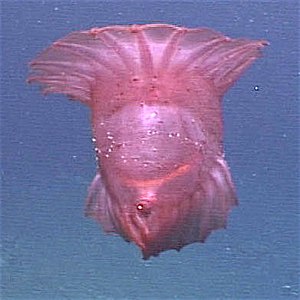Enypniastes eximia
| Enypniastes eximia | ||||||||||||
|---|---|---|---|---|---|---|---|---|---|---|---|---|

Enypniastes eximia |
||||||||||||
| Systematics | ||||||||||||
|
||||||||||||
| Scientific name of the genus | ||||||||||||
| Enypniastes | ||||||||||||
| Théel , 1882 | ||||||||||||
| Scientific name of the species | ||||||||||||
| Enypniastes eximia | ||||||||||||
| Théel , 1882 |
Enypniastes eximia is a species of deep- sea sea cucumber .
description
The species reaches body lengths between 6 and 25 centimeters. The body is barrel-shaped with a large webbing ("sail") sitting at the front end, which is formed from the extensions of 12 interwoven conical feet (podia) that serve as rib-like supports. Laterally near the rear end (posterolateral) there are two more rectangular webs with 10 to 15 podia. The body is semi-transparent in youth, internal organs, especially the filled intestine, are visible. The color depends on the body size: young specimens are pale pink, older animals are dark brown-red to purple-red and opaque.
Bioluminescence
The species is remarkable for its luminosity ( bioluminescence ). The glow is triggered by touch; it is bound to hundreds of small grains in the brittle and sticky, gelatinous integument of the animals. It is assumed that the luminosity serves to protect against predators. Predatory fish are literally highlighted by the peeled off, glowing skin, which reduces their future hunting success. The discarded integument is replaced in a few days.
Swimming ability
The species has webbed fronts and backs that allow it to swim around. This ability helps the animals to move to new grazing grounds and avoid danger. A total of about 20 species of swimming sea cucumbers are known that live in the deep sea, plus there are six shallow water species with less pronounced swimming ability. According to the morphology, there are probably many more species that can swim, but they have not yet been observed swimming.
According to previous observations, Enypniastes eximia seems to only go to the seabed to eat and spend the rest of the time swimming. The animals swim away from the seabed by sudden, synchronous downward movement of the front and rear webs, which catapults the animal upwards at an angle. Buoyancy is mainly generated by the flapping of the large front sail, the webbed sides serve more to stabilize the swimming position. The animals swim mainly with their bodies held vertically, with the front end down. A swim stroke takes about 7 to 8 seconds.
Ingestion
Enypniastes eximia eats substrates. The mostly muddy fine substrate is picked up as a whole without any discernible selection. When moving forward over the ground, the tentacles, split at the tip, are stretched out and with their help, the substrate is shoveled towards the mouth. The movement is relatively fast, each individual only remains on the ground for about a minute during a feeding process. The forward movement occurs through the undulating undulation of the front web. In currents, the animal can be driven over the ground like a sail, with the tentacles acting as brakes.
discovery
The species was rediscovered in 1874 on the famous Challenger Expedition , the first marine expedition to explore the ocean floor. The first person to describe it, Hjalmar Théel, later only had material preserved in alcohol, partly incomplete and in a poor state of preservation. He named the genus after the Greek expression for dreamers.
distribution
The style is cosmopolitan . Evidence is available from the entire Pacific at sea depths between 300 and 6,000 meters. It has also been recorded in the Atlantic ( Gulf of Mexico , Azores , Cape Verde , European coastal waters) and in the northern Indian Ocean (sometimes under synonymous names).
Systematics
Enypniastes eximia is the only species of the genus Enypniastes, which is monotypical with it . Synonyms this are Enypniastes decipiens Koehler & Vaney, 1910, Enypniastes globosa Hansen & Madsen, 1956, Euriplastes atlanticus Heding, 1940, Euriplastes obscura Koehler & Vaney, 1905, Pelagothuria bouvieri HEROUARD, 1906, Peniagone ecalcarea Sluiter, 1901 Planktothuria diaphana Gilchrist, 1920 .
Web links
Individual evidence
- ^ A b c d John E. Miller & David L. Pawson (1990): Swimming Sea Cucumbers (Echinodermata: Holothuroidea): A Survey, with Analysis of Swimming Behavior in Four Bathyal Species. Smithsonian Contributions to the Marine Sciences Number 35.
- ↑ Bruce H. Robison (1992): Bioluminescence in the benthopelagic holothurian Enypniastes eximia. Journal of the Marine Biological Association of the United Kingdom, Volume 72, Issue 02: 463-472. doi : 10.1017 / S0025315400037826
- ↑ Bruce H. Robison (2004): Deep pelagic biology. Journal of Experimental Marine Biology and Ecology 300: 253-272.
- ^ Suguru Ohta (1985). Photographic Observation of the Swimming Behavior of the Deep-Sea Pelagothuriid Holothurian Enypniastes (Elasipoda, Holothuroidea). Journal of the Oceanographical Society of Japan Vol. 41: 121-133.
- ↑ first description (digitized)
- ↑ Okeanos Explorer Homepage
- ^ Enypniastes eximia on Biological Information System for Marine Life
- ↑ a b Entry in WoRMS World Register of Marine Species